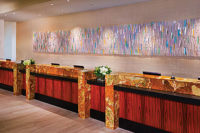“The idea for my sinks came from a machine I made to make Lazy Susans from scrap granite,” said Joe Pauly of Granite Wright. “The machine cut a 17-inch circle from a 19-inch square piece of granite. It was the square piece, with the circle cut out, that got me thinking that if I could make smaller and smaller circular pieces, and then epoxy them together, the inside would be the shape of a sink.”
Pauly explained that he has always enjoyed both inventing things, as well as making something from items other people throw away. As somewhat of a perfectionist, he has steadily improved the sinks over the last five years.
The company creates both vessel and undermount sinks. During the manufacturing process, the available scrap products for each sink are photographed, numbered, recorded for color reference and shelved. This inventory of “sink blanks” is available to be made into vessel or undermount sinks at customer request. Pauly starts out with a piece of scrap big enough to make two 16-inch-diameter circles. He has nine machines that do various steps in making a sink. Some of the machines are modified metal-working machines, and some he built himself. The machines make tapered rings of different sizes that are then epoxied together. The shape of the sink is about 95% of the finished shape after epoxying. The last part of shaping and polishing is done by hand with electric center water-fed polishers.
For the most part, Pauly said that quartz surfacing works best in manufacturing these sinks. “The color and grain of quartz makes a sink look like it is made from one piece, and the finished surface is as smooth as porcelain,” he said. “Most granites do not make a good quality sink. They tend to have natural flaws that are enhanced once you get past the resigned surface. However, there is a small number of granite types that can be used to make a very nice sink.” An added benefit, he explained, is the ability to repolish them if they ever get dull, scratched or start to look worn.









